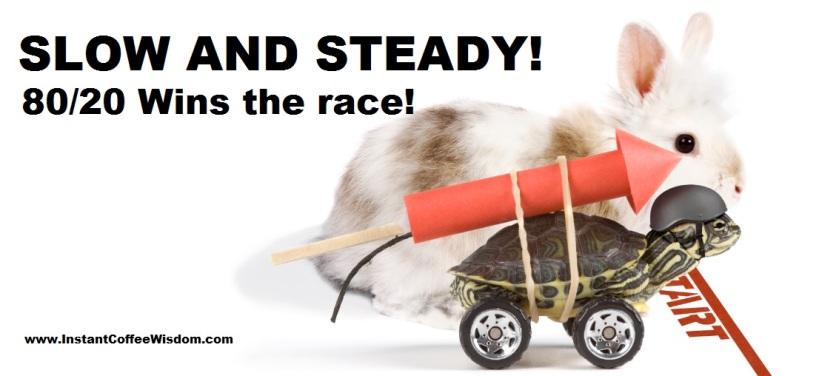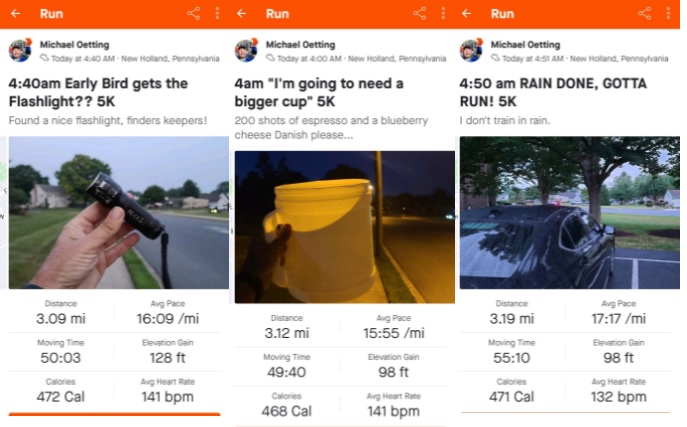80/20 wins the race!

At the 1952 Summer Olympics in Helsinki, runner Emil Zátopek of Czechoslovakia won 3 gold medals. He took running’s highest honor at the games in both the 5,000 (24 July 1952)and 10,000 (20 July 1952) meter runs, and then decided AT THE LAST MINUTE to run the marathon (27 July 1952) FOR THE FIRST TIME! Zátopek is the ONLY runner to win all three gold medals at the same Olympic games. Runner’s World Magazine declared him to be the greatest runner of all time in 2013. He pioneered the use of High Intensity Interval Training (H.I.I.T) known to most runners today just as intervals or speed-work.
Zátopek was a beast! A force of nature. His grueling training regiment topped out at 175 miles (281.63 kilometers) per week! Protégés who attempted to mimic his training methods burned out after a few years, or seriously injured themselves.
Speed-work is the most widely embraced method to improve running performance, BUT it is NOT the ONLY way. It is possible to get fast by going SLOW!
An unlikely coincidence
When Emil Zátopek first hit upon the idea of H.I.I.T (pun intended) he was working in a shoe factory in Zlin, Czechoslovakia. A couple of years later on the other side of the world, Arthur Lydiard was working in a shoe factory in Auckland, New Zealand. He came up with the notion that the key way to maximize running fitness was by tacking on distance running at a slow pace. A quantity over quality approach designed to build up stamina and endurance. Lydiard fancied himself to be in fantastic shape. He played rugby! One fateful day, his friend Jack Dolan (a central figure in the Auckland running community) goaded Arthur into running against him in a 5 mile race. Needless to say, rugby training doesn’t carry over well into short distance running. Lydiard got his ass kicked by Dolan. The race nearly killed him. His humiliation at the hands of his friend was what lead him to the idea of adding distance and decreasing the pace.
Lydiard realized that no runner, regardless of training or ability, can sustain their top speed for more than half a mile. After that, their pace would decrease incrementally over distance as fatigue set in. Any runner who has run middle to long distance races is familiar with the concept that it’s not the distance that kills you, it’s the pace. Runners who shoot out like jackrabbits at the start of the race sometimes find themselves being passed by runners who slowly crept back up by running at a much slower race.
Arthur Lydiard spent many months perfecting his slow training method. At the height of his training, he was running 250 miles (402.3 kilometers) a week! This proved to be too much. Lydiard soon realized that he felt best when running 100 to 120 miles per week, and that he could always run again after a day of training if he kept the pace slow. He also played with the pace, alternating distances, etc.
Once he had it all figured out, his typical training week was:
- Monday 10 miles
- Tuesday 15 miles
- Wednesday 12 miles
- Thursday 18 miles
- Friday 10 miles
- Saturday 15 miles
- Sunday 24 miles
Arthur Lydiard never personally won a Gold medal at the Olympics, but he did coach protégés who took 2 gold medals at the 1960 games in Rome. His training methods evolved into what is known as 80/20 running. the 80/20 rule of running training states that 80% of your weekly training time should be done at an easy effort level, with 20% consisting of harder running. Getting the miles is more important than speed-work. This flies in the face of logic for many, but the idea is about maintaining your heart rate in certain zones, while training your mind that this running thing ‘isn’t so bad’. Your pace should be below the ventilatory threshold, meaning that you can carry on a conversation while running, and you are not winded and gasping for air.
If I only had a brain…
Running is more of a mental discipline than it is physical. As your body grows fatigued, your brain begins to say STOP. You start thinking to yourself ‘I can’t do this anymore’. Here’s the thing, our bodies are capable of going further even though our minds are telling us that we can’t do this anymore. It’s like a fail-safe. We ‘think’ we are at our limit, so our mind tells us to stop, but in reality we can push ourselves much further than we thought possible. By focusing on distance rather than time, we train the body and the mind at the same time. By keeping our heart rate in a lower zone by running at a slower pace, we can run further without setting off the mental alarm bells telling us to STOP! It really is all in your head.
The week of SLOW
The biggest mind challenge for the runner is to keep a slow pace while knowing that you can run much faster. This is about distance, NOT time. When we race, we want the best time. 80/20 training is all about keeping it slow and steady. Training should never be at your race pace! 80% of your runs should be done at low intensity. You should feel like you can just keep running all day if you had to. You were born to run! Running is as natural as breathing. You wouldn’t stop breathing because you were too tired, would you? The remaining 20% of your training is done at moderate to high intensity, but also just shy of race pace.

AGAIN training is NOT racing. Save that burst of incredible speed for the big race, but don’t run so fast that you burnout 20% short of the finish line. Smile and wave as you pass the jackrabbits who shot ahead at the start.
80/20 vs the Clydesdale
Clydesdales are a race horse of a different color, and 80/20 training is a trickier proposition. A Clydesdale is a term for an larger, overweight runner. We are a separate racing division , pursing our own path to fitness. Depending on what source you site, the pace between running and walking transitions between 12mph and 15mph. Clydesdales usually run at a much slower pace than the average runner, so there is much less wiggle room to run slow. I am a Clydesdale, and the struggle is real. No Clydesdale is ever going to burn up the track and take 1st place overall in a race unless that horse is on fire!
My fastest pace mile to date is 10min 1sec. My average pace is between 12min and 13min per mile. I can sustain a 12 minute per mile pace for up to one hour, after that my pace drops like a rock. This is why I am studying 80/20 running vs. High Intensity Interval Training. This body was not built for speed.
A skinny runner who can manage a 6-minute mile can effortlessly transition to a 12-minute mile. A Clydesdale who already runs at a 12-minute mile is hardly running much slower at a 15-minute pace by comparison.
If a ‘skinny’ runs 5 miles at a 6min pace, they are done in 30 minutes. A Clydesdale running a 12min pace takes ONE HOUR to cover the same distance. Our race takes longer, and the mental fatigue telling us to give up is that much more intense at the finish. The ONLY way to overcome this is to condition our mind and body toward increased stamina and endurance via 80/20 training.
For more information on 80/20 running, I highly recommend the book 80/20 RUNNING by Matt Fitzgerald. The book also contains dozens of pages of training plans for 5K to full marathon, and was used as the source material for this article.
You can find me at these upcoming races:
JULY 2021
Third Thirsty Thursday 5K Race Series – Race 4/7 July 15 @7:00 pm Reading PA
Be sure to check back on July 25th for another article.
As always, I wish you success and happiness!




Another good read ,thanks. And happiness rigntback
at ya.
LikeLiked by 1 person